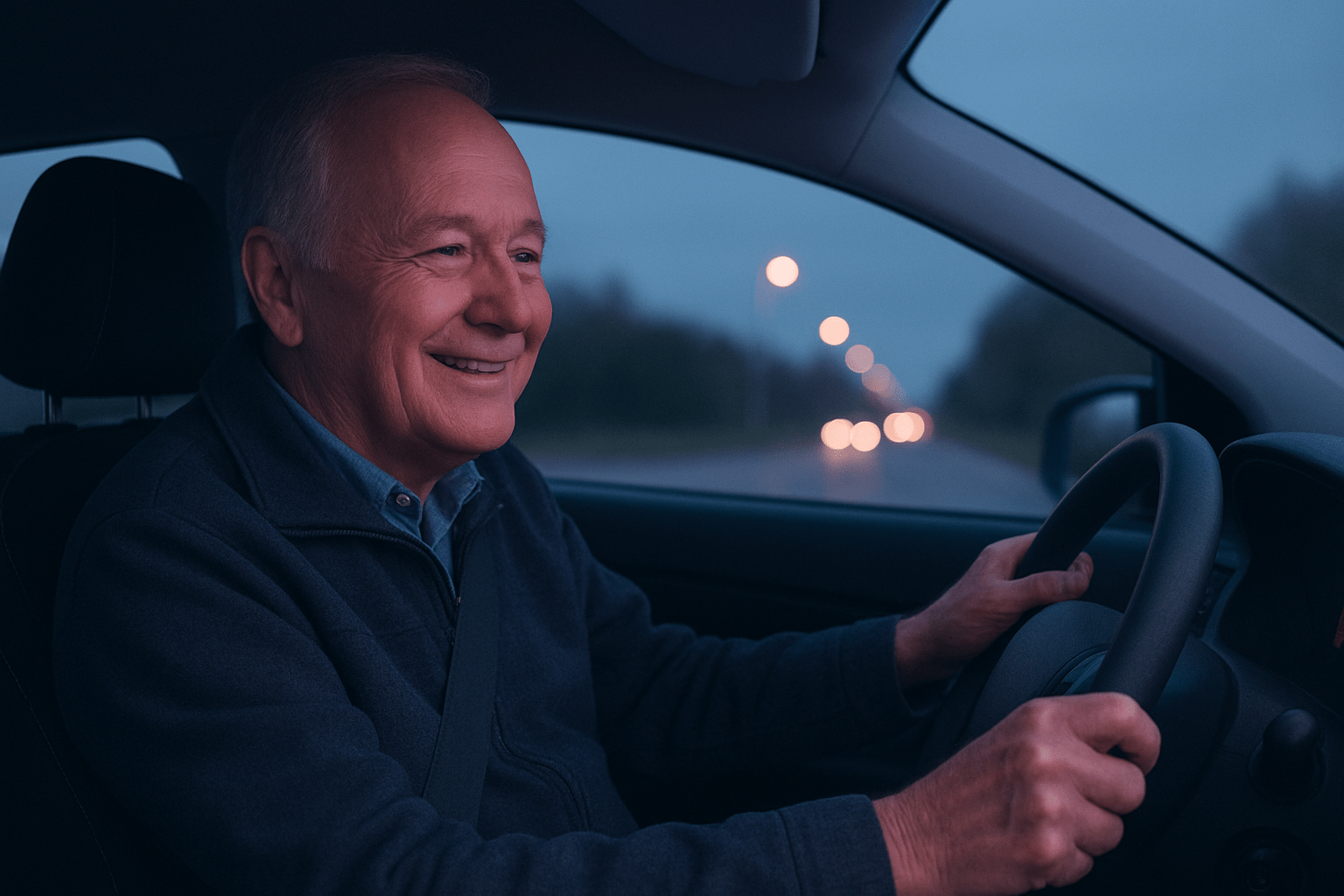As daylight hours shrink and evenings grow darker, many drivers find that what was a mild annoyance in summer becomes a serious safety issue. For people with cataracts, the seasonal shift can turn manageable vision impairment into a dangerous liability on the road.
At Solasta Healthcare, we often see patients who only realise how badly their night vision has declined once the clocks change. In this article, we’ll explain how cataracts affect driving in low light, summarise UK / DVLA vision standards (2025 update), share key statistics, and suggest what you can do if driving becomes difficult.
How Cataracts Impair Night Driving
A cataract is a cloudy or opacified area in the eye’s natural lens, causing light scatter, reduced clarity, and a drop in quality of vision. Many of its effects worsen under low light or glare conditions. Some of the main issues:
- Increased glare & halos: Oncoming headlights, streetlights, or reflections from wet surfaces produce halos, starbursts or scattered glare, because the cloudy lens diffuses light.
- Reduced contrast sensitivity: In dim lighting, distinguishing edges, low-contrast objects (e.g. pedestrians wearing dark clothing), or road markings becomes much harder.
- Slower adaptation: Transitioning from bright to darker zones (e.g. leaving a lit garage, tunnel, or shop) takes longer; your eyes struggle to adapt.
- Worsening aberrations when pupil dilates: In darkness, the pupil enlarges, letting more peripheral rays through a less perfect lens, thereby magnifying visual defects.
- Scattering from moisture, mist, wet roads: Rain, mist or spray increase light scatter, compounding glare and reducing clarity.
- Visual fatigue and strain: Driving in suboptimal vision conditions demands more effort, increasing tiredness, reaction time delays, and discomfort.
Many drivers note that they didn’t perceive a serious problem until the evenings lengthen. In fact, eye health professionals sometimes refer to this seasonal shift as “cataract season,” when patients first notice difficulties with night vision.
Key Statistics & Research Findings
Understanding the magnitude of the problem helps underscore the importance:
- A UK study of elderly drivers found 7.2% had bilateral visual field defects, and among drivers with visual acuity below the legal standard, 93% had cataract, refractive error, or both.
- In a long-term follow-up of drivers after cataract surgery, 14% of active drivers never resumed night driving (i.e., only drove during daytime) over two decades.
- Research simulating early cataracts under glare conditions showed measurable declines in detecting pedestrians and responding in night-driving simulations.
- According to the Eye Care Trust, the number of road accidents is significantly higher at night, in part because of increased visual demands. eyecaretrust.org.uk
- A survey by the College of Optometrists and RAC revealed 25% of drivers who find vehicle headlights “too bright” now drive less at night, and about 5% have stopped night driving altogether. college-optometrists.org
These data suggest that a significant portion of drivers, especially older ones, are likely operating with compromised vision — sometimes without recognising the magnitude of the issue.
UK / DVLA Vision Standards & Recent Updates (2025)
Driving licence vision rules are set by the DVLA (with shared UK rules, applicable in Northern Ireland too). It’s crucial to know both legal minimums and your responsibilities.
According to the DVLA’s latest guidance (INF188/1, updated February 2025) and associated sources:
- Number plate test: You must be able to read a standard vehicle number plate (issued after 1 September 2001) at 20 metres, with glasses or contact lenses if needed.
- Visual acuity: You must have decimal 0.5 (6/12) on the Snellen scale, with both eyes together (or with your better eye if only one eye has usable vision).
- Field of vision: You must have an adequate visual field horizontally — often interpreted as at least 120° horizontally (with at least ~50° to each side) without significant defects within 20° of fixation.
If you need glasses or contact lenses to meet these standards, you must wear them every time you drive.
Why the Dark Evenings Make Cataract Driving Risk Much Worse
Cataracts already impose a burden on vision; seasonal changes amplify that burden:
- More hours of low or no daylight: Journeys once done in daylight may now occur in dusk or dark conditions.
- Increased glare from headlights & street lighting: The glare effects of cataracts are magnified at night, especially from oncoming cars or reflections.
- Weather & road surface effects: Rain, mist, fog, and wet roads increase light scatter and reflections.
- Rapid light transitions: Moving from lit places (shops, car parks) into darkness demands quick eye adaptation, which cataract-affected eyes struggle with.
- Behavioral adaptation: Many drivers reduce or avoid night driving when glare becomes too uncomfortable. (Recall that 25% of drivers who find headlights too bright now drive less at night.)
- Earlier symptom recognition: Some people only notice the change once it’s dark earlier — the “cataract season” phenomenon.
Because of this, many individuals first become aware of how much their vision was deteriorating once the evenings darken.
What Drivers Can Do (Before Surgery)
While cataract surgery is often the definitive solution, there are interim steps to help reduce risks:
- Avoid night driving if possible, or limit it to well-lit, familiar routes.
- Use anti-reflection / anti-glare coatings on your driving spectacles to reduce stray reflections and halo effects.
- Keep all surfaces clean — windscreen, mirrors, glasses, headlight covers — because even small smudges or grime exacerbate scattering.
- Ensure your vehicle’s headlights are clean, properly aligned and in good condition, with quality legal bulbs.
- Increase following distances and reduce speed in glare or low contrast conditions.
- Prefer well-lit roads over dark, rural routes when possible.
- Have frequent eye examinations, especially if you notice any worsening glare, halos, or difficulty driving after dusk.
- Always wear corrective lenses when driving (if needed) — never remove them during your journey.
These measures may help temporarily, but cannot fully counter the light scattering and contrast loss caused by a cloudy lens.
When to Consider Cataract Surgery — Especially for Drivers
Many patients begin considering surgery when their visual problems start interfering with daily tasks. For drivers, the tipping point is often reached when:
- Glare, halos or dazzling lights become prominent and unavoidable
- Night driving becomes uncomfortable or unsafe
- You no longer feel confident on poorly lit or unfamiliar roads
Cataract surgery is among the most common and safe elective eye surgeries. It often restores visual clarity, reduces glare, and improves contrast sensitivity — enabling patients to resume driving more safely (subject to a post-op vision check).
If you’re considering private cataract surgery, book a consultation with an experienced specialist today to explore your options and regain clear vision without the wait!
Start Your Journey at Solasta Healthcare!
Call today: 028 40 648 486
Email: info@solastahealthcare.com

